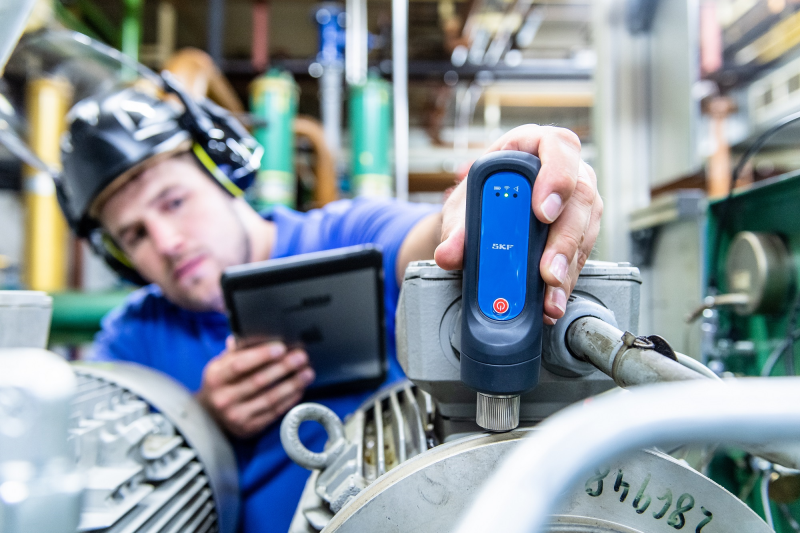 Monitoring a variety of bearing parameters, including temperature and vibration, can spot damage early and prevent catastrophic failure and costly downtime.
Monitoring a variety of bearing parameters, including temperature and vibration, can spot damage early and prevent catastrophic failure and costly downtime.
Here is the good news about bearings: 90% of them outlive the machine in which they are installed. However, the bad news is that of the remainder that require replacement, around 5% fail in service. It is these instances that can lead to catastrophic failure, breakdowns and expensive downtime.
The cost of bearing failure on manufacturing is incalculable, but the agreed way to tackle it is to adopt a condition monitoring strategy. For instance, one UK rail network has begun using vibration sensors to identify bearing damage in rail axlebox bearings. Similarly, delegates at a recent wind turbine conference heard how vibration data boosted failure prediction of rolling bearings in wind turbine gearboxes. This could help control operating and maintenance costs.
Condition monitoring relies on tracking and analysing key operational parameters such as noise, vibration, temperature and lubrication conditions – that indicate the first signs of bearing damage. By measuring these, and comparing them with ‘normal’ results, manufacturers can spot the earliest signs of impending bearing failure and replace them in good time.
Damage progression
Once damage has begun in a bearing, such as through spalling on the raceway, early detection allows for faster corrective action, which reduces the chance of unplanned downtime. At the earliest stage, the damage is effectively invisible. However, condition monitoring techniques can detect the beginnings of failure relatively quickly, by sensing abnormalities, such as an irregular vibration pattern, or elevated temperature.
Problems are usually manifested in five different ways: heat, noise, vibration, shaft movement and frictional moment to rotate the shaft. Each can be caused by a number of conditions.
For instance, ‘excessive heat’ could be down to under- or over-lubrication, but could also be caused by seal problems (such as excessive tightness, or incorrect orientation), insufficient clearance (which could have multiple causes) or improper bearing loading.
For this reason, monitoring temperature can help to spot early signs of damage. If operating conditions have not been changed, an increase in temperature often indicates imminent bearing damage. However, a natural temperature rise, which can last a day or two, is often seen just after first machine start up, and after each relubrication when using grease.
Making a noise
Monitoring noise and vibration is another common and effective way of identifying bearing damage. While bearings in good condition produce a sound akin to ‘purring’, those in poor condition make grinding or squeaking noises, a sure sign of problems.
Vibration monitoring is effective for three main reasons: all machines vibrate; a growing mechanical problem is usually accompanied by increased vibration and the nature of the fault can be determined from the vibration characteristics. The technique uses sensors (or ‘accelerometers’) to listen to the characteristic vibration pattern emanating from a rotating bearing, comparing it with a ‘standard’ pattern, and flagging up if there is a serious discrepancy.
Incorporating a technique called acceleration enveloping, a signal processing method that filters out unwanted noise – improves the effectiveness of vibration monitoring and can spot problems even earlier.
Monitoring lubrication
Poor lubrication is responsible for around one-third of bearing failures, so keeping on top of lubrication conditions is an effective way of preventing bearing damage. ‘Poor lubrication’ can mean several things: the wrong lubricant is being used; incorrect dosing; or re-lubricating at the wrong intervals. There are several recommended ways to tackle this:
• Checking for leaks in the areas around bearing positions;
• Keeping protective collars and labyrinth seals filled with grease for maximum protection;
• Checking that automatic lubrication systems are working properly;
• Checking lubricant levels in sumps and reservoirs, and keeping them topped up as needed;
• Re-lubricating according to schedule (for manual processes);
• Ensuring that the specified lubricant is always used.
During service, lubricant condition should be assessed periodically, preferably by taking samples and having them analysed, which is a useful way to spot problems.
Failed bearings can also be minutely analysed after they have been removed. While this may appear to be ‘too late’, it can indicate the underlying reason for failure – which can then be remedied. However, in order to avoid reaching this level, monitoring in-process conditions is the best way to ensure that bearing failure is caught as early as possible.
https://www.skf.com/uk/products/condition-monitoring-systems
SKF (U.K.) Limited
T: 01582 490049 marketing.uk@skf.com www.skf.co.uk

